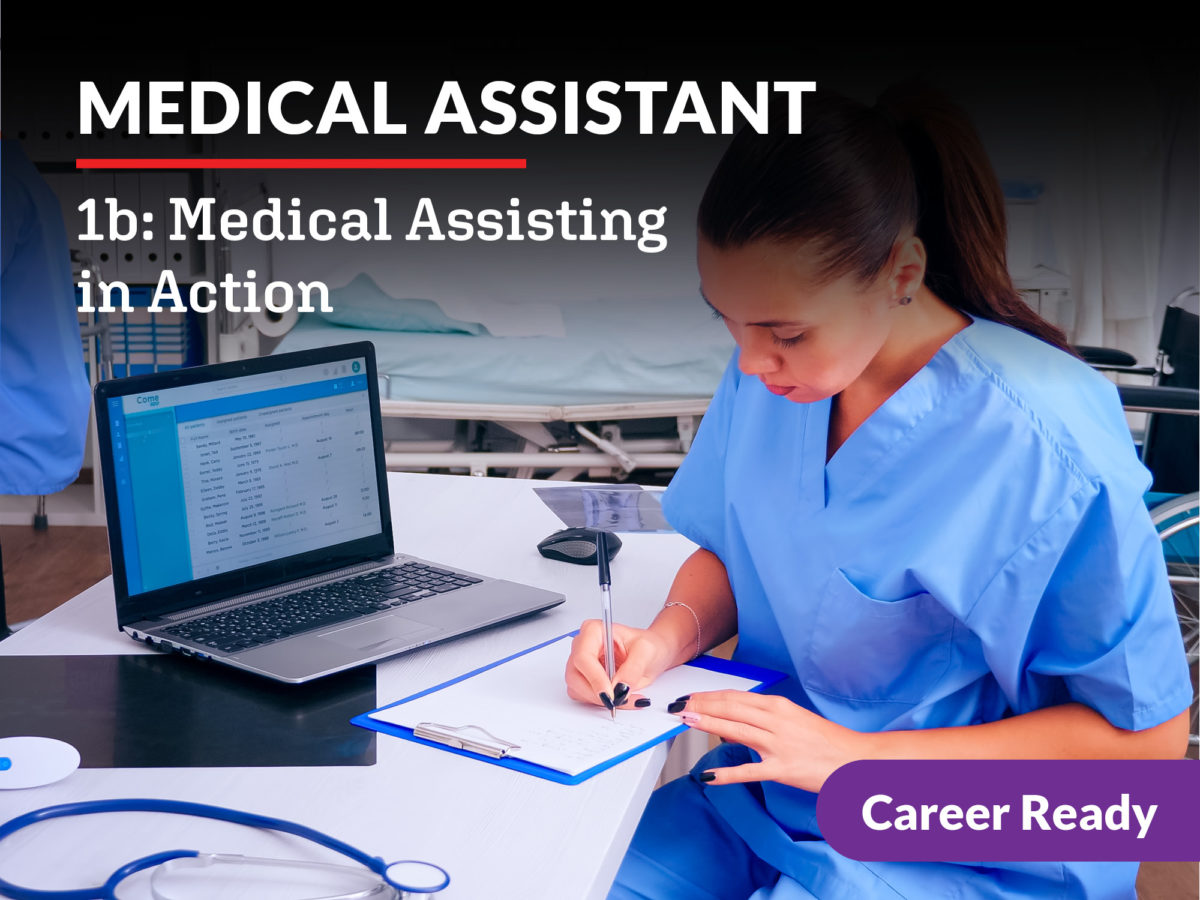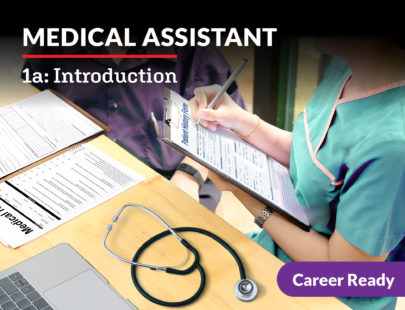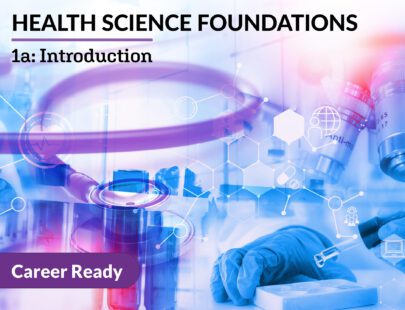
Medical Assistant 1b: Medical Assisting in Action
It’s time to grab your latex gloves and snap them back into place so you can get a deeper look into the world of medical assisting! In this course, you’ll explore patient care and procedures, testing and care coordination, pharmacology and safety, and reimbursement and the law. You’ll also narrow your areas of interest so you can better determine what type of medical assisting may be best for you. Are you ready to continue on the road to medical assisting? Grab your lab coat and let’s get going!
Units at a Glance
Unit 1: Healthcare and the Law
How does the legal system influence the healthcare world? A quick answer to someone on the outside may be “not much,” but in fact, many legal and ethical aspects provide guidance for all types of medical professionals. From toeing the legal and ethical line to reporting violations, a medical assistant needs knowledge of these topics to stay within the bounds of the profession. When health and lives are on the line, you can bet the law has something to say about it!
What will you learn in this unit?
- Describe the difference between ethical and legal requirements and recognize basic legal terminology as it relates to professional liability
- Identify laws and legal obligations related to a healthcare professional
- Analyze legal requirements related to privacy and confidentiality of patient information
- Explain legal documents related to informed consent and advance directives and how these documents are used in the healthcare environment
- Summarize the importance of recognizing and reporting any legal or ethical incidents or violations
Unit 2: Maintaining a Safe Environment of Care
When you go into any healthcare facility, you probably don’t give much thought to how they are keeping you safe. For something we often overlook, safety is actually a major focus for all healthcare workers. As we explore things like infection control, safety standards, and proper body mechanics, we’ll take a magnified look at all the little things that go into safety procedures. Let’s see what it takes to maintain a safe environment for our patients and ourselves.
What will you learn in this unit?
- Identify modes of transmission of infection and methods of infection control to stop them
- Analyze levels of infection control and apply them to the sterile environment
- Describe keys to proper body mechanics and patient positioning
- Recognize OSHA safety standards within health care and methods of implementation
- Evaluate the importance of quality control procedures within healthcare organizations
Unit 3: Pharmacology
Imagine a time when you were sick enough to go to the doctor. You were examined and prescribed medication, went to a pharmacy to get it filled, and took it as directed on the bottle. Sounds fairly simple, right? Actually, it’s really not as simple as it sounds. All kinds of medications are available to treat a range of conditions and can be given in a variety of ways. Medical assistants need knowledge of pharmacology as part of their everyday practicing skills. Let’s discover the ins and outs of the not so simple world of pharmacology!
What will you learn in this unit?
- Define pharmacokinetics, including drug classifications and schedules
- Identify the routes of medication administration and the role of the medical assistant
- Analyze methods used to properly handle medications as well as ways to calculate dosages
- Demonstrate knowledge of commonly prescribed medications and commonly used abbreviations on prescriptions
- Describe immunization schedules and requirements
Unit 4: Patient Care Essentials
Have you ever thought about the coordination required to manage patient flow in a medical facility? With so many patients needing to be seen by providers each day, it takes organization and a team effort to keep things going at the right pace. Medical assistants play a large part since they are often the first friendly face in the process. Knowing the importance of this role, we’ll explore the skills it takes to care for patients throughout this process. While some expertise are contingent on the type of office or healthcare organization environment, others are essential for every situation. Let’s start by investigating patient care essentials.
What will you learn in this unit?
- Measure vital signs and other patient assessment data as part of the initial intake process
- Demonstrate knowledge of BLS and CPR
- Recognize signs and symptoms of conditions that constitute a medical emergency
- Identify common conditions like burns, poisoning, bites, cuts, and hot/cold exposure and the first aid skills needed to treat them
- Describe conditions like asthma, hyperventilation, and the differences between common muscle or bone injuries and first aid skills to treat them
Unit 5: Procedural Patient Care
If you break down the term medical assistant, you can guess that these healthcare professionals help with things related to the medical field, but what does that mean? Is something stuck in a patient’s ear? Does a patient need education on how to manage their diabetes? How do you help a patient cope with end-of-life issues? From eyes and ears to skin, lungs, and toes, medical assistants help with all types of procedures, instruction, and counseling. As we explore the role of the medical assistant further, we’ll learn the basics of these procedures and the patient care skills it takes to master this profession.
What will you learn in this unit?
- Explain methods of testing eyes, ears, and reflexes as part of the patient examination
- Describe steps in assisting with different types of allergy and respiratory tests and treatments
- Discuss methods for assisting with common non-surgical and surgical procedures
- Demonstrate accurate documentation methods while assisting with general physical exams
- Educate, screen, and counsel patients based on provider orders
Unit 6: Laboratory Testing
When a patient comes into a healthcare facility seeking answers about their health, providers compile the signs and symptoms to try to determine the cause of the problem. Often those clues aren’t enough, so they turn to laboratory testing. Since this type of testing plays a huge part in diagnosis, medical assistants need knowledge of the types of tests available and how to perform them. As we explore the world of laboratory testing, we’ll learn everything from collection and normal versus abnormal values to quality control for this type of environment.
What will you learn in this unit?
- Describe common tests using blood samples along with normal and abnormal results
- Identify common tests using methods other than blood along with normal and abnormal results
- Explain methods of blood collection including techniques and sampling processes
- Recognize methods of collection and sample handling for samples other than blood
- Analyze laboratory processes and quality control standards
Unit 7: Other Types of Testing and Care Coordination
As providers evaluate patients to decide on a diagnosis, they use the physical exam and the laboratory results as steppingstones to set them in the right direction. To confirm a suspected diagnosis or to narrow down the possibilities, they turn to other types of testing. As we explore this next step in the diagnostic process, we’ll see how performing an EKG, recognizing normal versus abnormal rhythms, and differentiating between other diagnostic techs are important skills for a medical assistant helping to coordinate this part of the care process. In addition, we’ll see the adjustments needed when educating patients about all aspects of their care.
What will you learn in this unit?
- Identify the parts of an EKG wave and how it corresponds to the heart’s electrical conduction pathway
- Describe the process of performing types of EKGs
- Differentiate between artifacts and critical versus non-critical arrhythmia
- Explain various types of computer-based diagnostic testing
- Analyze the team-based approach to health care and ways to coordinate the patient care process
Unit 8: The Reimbursement Process
When someone mentions working in health care, most people think of working with patients, completing tasks like taking vital signs, performing tests, or providing bedside care. Have you ever wondered how this health care gets paid for? An often overlooked, but just as important, part of the medical world is the reimbursement process. From prior authorizations to coding and billing for services, medical assistants play a big part in making sure things go smoothly and providers get paid for their services.
What will you learn in this unit?
- Explain the importance of insurance and the types of insurance available to patients
- Describe various healthcare delivery models and the incentives available to providers to reduce the cost of care
- Discuss processes and actions in the reimbursement process that help prepare for a patient’s visit
- Identify methods of medical billing and coding
- Analyze ways to identify errors and resolve issues in a medical practice
Required Materials
Physical
- Art supplies
- Digital camera
- Eye cover (wooden spoon)
- Measuring tape
- Poster board
- Video recording device
- Watch or timer
Software
- Presentation software
- Word processing software
Other
- Helper
- Medical reference sources, print or online
- Standard dictionary
Optional
- Audio recording device
- Design software
- Doll/stuffed animal
- Graphic design software
- Index cards
- Printer
- Various household items
- Writing supplies




